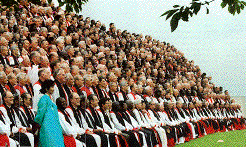

As its name implies, the Lambeth Conference first met at the Archbishop of Canterbury's London home, Lambeth Palace. But the bishops moved, in 1978, to Canterbury, whose great cathedral was the birthplace of English Christianity in 597 AD. St. Augustine, the first Archbishop of Canterbury, lived there and 102 subsequent archbishops have since occupied the St. Augustine's Chair. Augustine of Canterbury, abenedictine prior sent to England with 40 monks, was the first Christian authority welcomed by a ruler of the Anglo-Saxon Kingdom. He baptised its king, Ethelbert.
The murder of
Thomas BeckettThe famous Cathedral, whose three towers seem to glow in the brightness of the Southeast England light, has been sacred to pilgrims ever since the martyrdom of Archbishop Thomas Becket. Canterbury promptly became an international pilgrimage shrine, Thomas was canonised and pilgrims flocked to the sacred site. Geoffrey Chaucer's Canterbury Tales and T. S. Eliot's Murder in the Cathedral give it an important place in English literature.
Eliot described Canterbury Cathedral as the rock of God beneath our feet and its archbishop as central to it. In the poet's own words:
Between sessions
at the 1988
Lambeth Conference
The Rock of God is beneath our feet. Let us meet the Archbishop with cordial thanksgiving: Our lord, our Archbishop returns. And when the Archbishop returns Our doubts are dispelled. Let us therefore rejoice, I say rejoice, and show a glad face for his welcome.
The Cathedral, rich in monuments from many periods, contains the tombs of Edward the Black Prince and King Henry IV. The Black Prince, eldest son of King Edward III, was the symbol of England's hopes in prolonged wars with France and an able military leader who died in 1376. His nephew, King Henry IV, who died in 1413, is the subject of two plays by William Shakespeare.
Choir boys practice
in the cloisters of
Canterbury CathedralThough many cathedral deans and archbishops of Canterbury are buried there, Archbishop Becket is not apparently among them. His jewel-encrusted tomb was stripped during the Reformation and his bones thought to have been destroyed.

This web site is maintained privately. Though not an official organ of the Anglican Church of Canada, the Church of England, the Episcopal Church in the U.S.A., or any church body, it does offer links to official news releases and other documents such as Constitutions and Canons, links to official parish/diocesan pages, and other such documents.